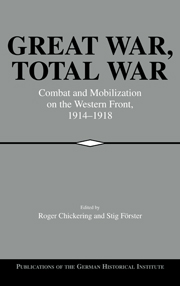Book contents
- Frontmatter
- Introduction
- PART ONE BASIC REFLECTIONS
- PART TWO THE CHANGING REALITIES OF WARFARE
- PART THREE WAR AGAINST NONCOMBATANTS
- 8 War Between Soldiers and Enemy Civilians, 1914-1915
- 9 The Blockade of Germany and the Strategy of Starvation, 1914-1918
- 10 Total Rhetoric, Limited War
- 11 The First Air War Against Noncombatants
- 12 Bullying the Neutrals
- PART FOUR POLITICIANS, SOLDIERS, AND THE PROBLEM OF UNLIMITED WARFARE
- PART FIVE MOBILIZING ECONOMIES AND FINANCE FOR WAR
- PART SIX SOCIETIES MOBILIZED FOR WAR
- Index
11 - The First Air War Against Noncombatants
Strategic Bombing of German Cities in World War I
Published online by Cambridge University Press: 05 January 2013
- Frontmatter
- Introduction
- PART ONE BASIC REFLECTIONS
- PART TWO THE CHANGING REALITIES OF WARFARE
- PART THREE WAR AGAINST NONCOMBATANTS
- 8 War Between Soldiers and Enemy Civilians, 1914-1915
- 9 The Blockade of Germany and the Strategy of Starvation, 1914-1918
- 10 Total Rhetoric, Limited War
- 11 The First Air War Against Noncombatants
- 12 Bullying the Neutrals
- PART FOUR POLITICIANS, SOLDIERS, AND THE PROBLEM OF UNLIMITED WARFARE
- PART FIVE MOBILIZING ECONOMIES AND FINANCE FOR WAR
- PART SIX SOCIETIES MOBILIZED FOR WAR
- Index
Summary
In September 1914 the first German civilian was killed in an air raid when a British plane bombed a zeppelin hangar in the city of Düsseldorf Less than eleven years before, in December 1903, the Wright brothers had constructed the first propeller-driven airplane, the “Flyer I,” which lifted sixteen feet off the ground and flew a distance of some 285 yards, remaining airborne for about a minute. Within less than half a generation, the airplane thus had developed from a fragile technical oddity into a deadly weapon. Its advent made possible for the first time in military history the spread of warfare for hundreds of miles behind the front lines. The year 1914 saw the birth of an aspect of modern warfare that seems to be foremost a feature of World War II - strategic bombing of the enemy's hinterland.
In World War I airplanes undertook primarily tactical operations and were used for reconnaissance, artillery spotting, fighting, or bombing at the front. Here they gained an importance comparable to that of other new weapons, such as tanks and submarines, but the statistics show that bombing outside the combat areas also played an increasing role as the war progressed. Between 1914 and 1918 some 15,700 bombs fell on German territory and killed about 740 people and injured almost 1,900 more, most of them civilians. The extent to which strategic bombing proliferated during the war is illustrated by the fact that half of all the bombs deployed were dropped in 1918 alone, causing half of the total losses.
- Type
- Chapter
- Information
- Great War, Total WarCombat and Mobilization on the Western Front, 1914–1918, pp. 207 - 226Publisher: Cambridge University PressPrint publication year: 2000
- 4
- Cited by



